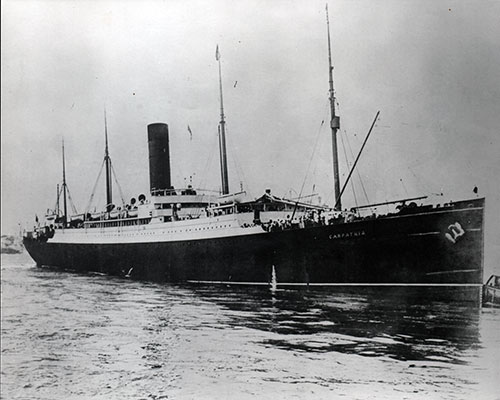It could have been the greatest rescue in maritime history.
Immediately upon receiving the distress signal, Captain Arthur Rostron ordered his ship to race to the aid of the stricken vessel. His crew rushed to ready their ship to receive two thousand survivors of the sinking passenger liner. Lifeboats were swung out; huge urns of hot coffee and soup were prepared; medical instruments were readied; nets, ladders and lights were rigged along the sides of the ship; and thousands of blankets were pulled from storage and piled for quick distribution.
On the steamship’s bridge, Captain Rostron measured the distance to the sinking vessel. At best speed, they could be there in four hours.
But the passengers and crew of the RMS Titanic didn’t have four hours. And by the time Captain Rostron’s RMS Carpathia arrived on scene, Titanic was gone and 1,517 people were dead – drowned or frozen in the icy sea.

RMS Carpathia
Carpathia rescued 710 survivors of the Titanic from the lifeboats that morning. But the rescue effort – conducted with exacting professionalism, compassion, and heroism – was overshadowed by the tragic deaths of so many others.
Like every disaster, the loss of Titanic and the deaths of more than 1500 persons were the result of a chain of circumstances, errors, misjudgments, and bad luck. Anywhere along the chain a different decision might have changed the outcome. Even after the ship had been built with watertight compartments that failed to reach the main deck; even after she was provided with a grossly insufficient number of lifeboats; even after she had rushed headlong into waters known to be harboring icebergs; even after the lookouts failed to spot the looming white mountain; even after the ship’s desperate last-second course change proved just enough to tear open multiple watertight compartments; and even after lifeboats were launched with empty seats; final catastrophe might have been averted.
If Carpathia had been twenty-five miles nearer, or if SS Californian, which was nearer, had received Titanic’s frantic distress calls, rescue ships might have arrived on scene before Titanic sank. Titanic would then be an ironic footnote – the unsinkable ship that sank – but she would not be remembered today as one of the greatest maritime disasters in history.
But the chain remained intact. Catastrophe wasn’t averted. No rescue ships arrived before fifteen hundred people were forced into the freezing water, where they paid the price for the errors of others: faulty design, overconfidence, inattention, and poor planning.
Captain Rostron, his crew, and the Carpathia’s passengers did everything in their power to save the passengers and crew of Titanic. They treated those that they could save with generosity and kindness during the four-day voyage to New York.
After her rescue mission, Carpathia resumed her passenger service on the Atlantic. Taken up for war service at the outbreak of World War I, she was torpedoed and sunk by a German submarine in July 1918 with a loss of five crew members. 275 persons were rescued.
April 14, 2019
